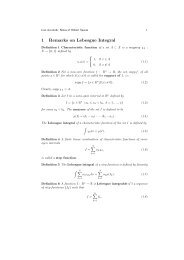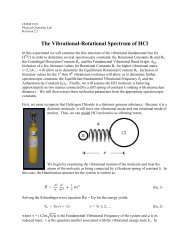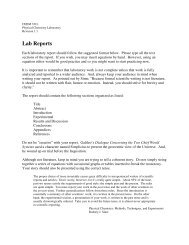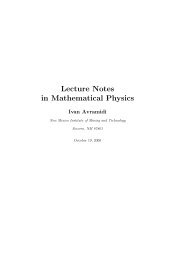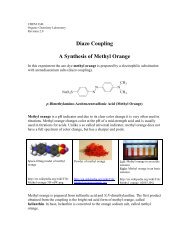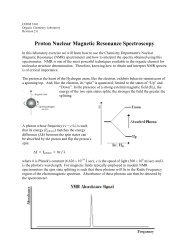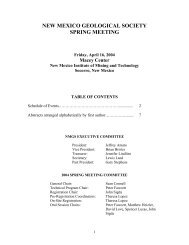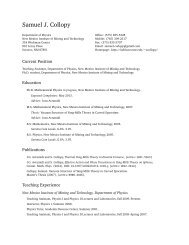A Magnetic α Ï Dynamo in Active Galactic Nuclei Disks - NMT Physics
A Magnetic α Ï Dynamo in Active Galactic Nuclei Disks - NMT Physics
A Magnetic α Ï Dynamo in Active Galactic Nuclei Disks - NMT Physics
Create successful ePaper yourself
Turn your PDF publications into a flip-book with our unique Google optimized e-Paper software.
– 7 –the buoyant magnetic loops (due to the cosmic ray pressure) was proposed <strong>in</strong> the context of the<strong>Galactic</strong> dynamo by Parker (1992) and detailed calculations of the result<strong>in</strong>g mean field theory wereperformed by Moss, Shukurov & Sokoloff (1999). In this case the matter, cosmic rays, would notfall back to the galaxy surface, but the <strong>in</strong>ertial mass of the cosmic rays is smaller than that of thegalactic matter by ∼ 10 −10 , aga<strong>in</strong> greatly reduc<strong>in</strong>g the back reaction limit. The buoyant dynamocan amplify the weak large-scale magnetic field, B c ∼ Rm −1/2 B equi , where B equi is the magneticfield <strong>in</strong> equipartition with the turbulent energy. However, the buoyant α is a fraction (generally, asmall fraction) of the velocity of the buoyant rise of the toroidal magnetic fields, u B = C(d/H) 1/2 v A ,where d is the radius of a flux tube, H is the half thickness of the disk, v A is the Alfvén speed,and C is a constant of order unity. For Rm ∼ 10 15 to 10 20 <strong>in</strong> the accretion disk, B c ∼ 10 −8 to10 −10 B equi . Alfvén speed will be about 10 −8 to 10 −10 of sound speed. As we show below, star-diskcollisions lead to a large mass ejected above the disk and therefore result <strong>in</strong> robust, large scalehelical motions of hot gas with the rotation velocity exceed<strong>in</strong>g the sound speed <strong>in</strong> the disk and,therefore, 10 8 to 10 10 times faster than the buoyant motions of the magnetic flux tubes. Thus, wecan safely neglect the buoyant dynamo <strong>in</strong> our calculations of the l<strong>in</strong>ear stage of star-disk collisiondriven dynamo.1.7. Star-Disk CollisionsIt has now been long realized that the collisions of stars form<strong>in</strong>g the central part of thestar cluster <strong>in</strong> AGNs with the accretion disk lead to the exchange and stripp<strong>in</strong>g (or possiblygrowth) of the outer envelopes of stars and also, <strong>in</strong>evitably, a change <strong>in</strong> the momentum of thestars. This makes an important impact on the dynamics of stellar orbits. Thus the evolutionof the central star cluster may contribute to provid<strong>in</strong>g accretion mass for the formation ofthe CMBH and can account for part of the observed emission from AGNs (Syer, Clarke, & Rees1991; Artymowicz, L<strong>in</strong>, & Wampler 1993; Artymowicz 1994; Rauch 1995; Vokrouhlicky & Karas1998; Landry & P<strong>in</strong>eault 1998). Zurek, Siemig<strong>in</strong>owska, & Colgate (1994) considered the physics ofplasma tails produced after star-disk collisions (see also Zurek, Siemig<strong>in</strong>owska, & Colgate 1996).They suggest that emission from these tails may account for the broad l<strong>in</strong>es <strong>in</strong> quasars. Here wesuggest another consequence of stars pass<strong>in</strong>g through the accretion disk, the generation of magneticfields.For this to happen on a large scale and at the Keplerian back reaction limit requires multiple,repeatable coherent rotation through a f<strong>in</strong>ite angle and axial translation of conduct<strong>in</strong>g matter wellabove the disk. We emphasize the importance of an experimental, laboratory demonstration of therotation and translation of plumes, driven by jets <strong>in</strong> a rotat<strong>in</strong>g frame (Beckley et al. 2003). Theselaboratory plumes are the analogue of those produced by the star disk collisions, which are thesource of the helicity fundamental to this dynamo mechanism.




